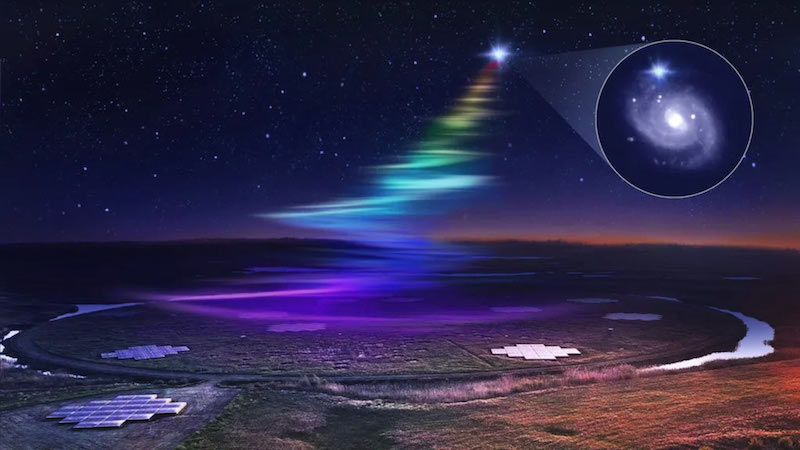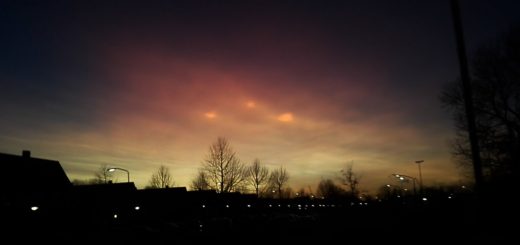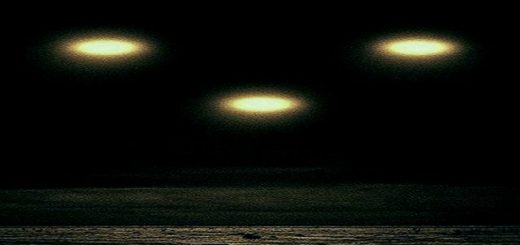Radio Waves From Famous FRB Surprisingly Long And Late

It was just over a decade ago that astronomers noticed bursts of radio waves from the cosmos, lasting just milliseconds, now known as fast radio bursts (FRBs). Today, these bursts are still shrouded in mystery, as astronomers work to gather clues to their nature. This month (April 2021), an international team of astronomers announced it has now broken an observational record for FRBs, by measuring radio bursts from one of the best-studied FRBs – known as FRB 20180916B – at lower frequencies (longer wavelengths) than ever before. They also found this very low frequency signal from FRB 20180916B arrives three days after higher frequency emission from the same object. This strange discovery provides new and important information about the enigmatic origin of FRBs.
The research was published in the peer-reviewed Astrophysical Journal Letters on April 9.
The paper’s lead author Ziggy Pleunis, a postdoctoral researcher at McGill University in Montreal, Canada, explained:
We detected fast radio bursts down to 110 MHz, where before these bursts were only known to exist down to 300 MHz. This tells us that the region around the source of the bursts must be transparent to low-frequency emission, whereas some theories suggested that all low-frequency emission would be absorbed right away and could never be detected.
The team studied a repeating FRB, known as FRB 20180916B, that was discovered in 2018. It is located in the outskirts of a galaxy similar to our Milky Way galaxy, at a distance of about 500 million light-years. Because this is considered close in astronomical measures and because the burst is repeating, the FRB has been the focus of several studies, revealing, for example, that is has a 16.3 day periodicity in its activity, meaning it sends out a new burst every 16 days. This made it the first predictable radio burst.
Pleunis told EarthSky that there are two prevailing explanations for the 16-days-between-bursts timing:
One possibility is that the FRB source is in a binary (double) system, and the FRBs only become observable from Earth for a few days once every orbital rotation. The rest of the time the emission is pointed away from us or obscured. The other possibility is that the FRB source is precessing [its magnetic pole is changing direction], and the FRBs only become observable from Earth for a few days once every precession period when the emission is pointed towards us.
Those explanations might explain the 16-days-between-bursts timing. But the new research also found that the emission from the FRB arrives at different times, depending on frequency (that is, in a manner directly related to how long the waves of the signal are). The team discovered that the newly observed low-frequency radio emission consistently arrived three days later than that of the higher frequencies.
Smiling man with a mustache and green leaves in the background.
Ziggy Pleunis at McGill University is the lead researcher of a new study that found fast radio burst signals at longer wavelengths than ever before, arriving 3 days later than their shorter wavelength counterparts. Image via Z. Pleunis.
How can that be? All electromagnetic emission travels at the same speed, the speed of light (186,000 miles per second, or 300,000 km per second). What would make the lower-frequency signal arrive so late? Pleunis explained to EarthSky these astronomers’ theory for the three-day delay:
In a lot of models, FRBs are produced in the magnetic field surrounding a neutron star [a highly compact star], in a beam or cone emanating from the magnetic poles of the star. It is thought that emission produced at different altitudes in this magnetic field – closer to or farther from the body of the neutron star itself – has different characteristic frequencies because of the changing conditions of the magnetic field. The higher-frequency radio waves would be produced at lower altitudes [closer to the neutron star] than the lower-frequency radio waves.
If there is indeed this kind of relationship between the distance from the star where the burst is produced and the frequency of the burst, Pleunis explained, then, due to the movement of the FRB in both of the 16-day burst scenarios, looking from Earth, you would first face the regions closer to the star before you would “see” the higher altitude regions. This means that you would first measure the emission with the higher frequencies and then, a few days later, you would observe the emission of the lower frequencies.
In other words, the delay in the arrival of the longer-frequency emission might be a consequence of the orientation of the neutron star and its magnetic field (assuming the models are correct that FRBs can be produced in a neutron star’s magnetic field). Pleunis continued:
If a similar FRB source is oriented differently with respect to Earth, it would be possible to see the lower frequency radio waves before the higher frequency radio waves in that system.
If you find all of this hard to visualize, you’re not alone. The inherent movement of the FRB complicates things, for one thing. To make it even more difficult, the magnetic fields are rarely uniform fields with two well-defined beams from each pole (the textbook case). Instead real magnetic fields in nature are a lot more messy.
Diagram: three bright stars with labels and beams shining from them.
This schematic illustrates the two possible scenarios for FRB production. In the first scenario (left), a neutron star and another star orbit a common center of mass. In this scenario, you can only see the FRB for a few days from Earth. In the 2nd scenario (right), the neutron star is solitary. Its magnetic pole – the possible source of the FRB signals – is precessing, or changing direction, which makes the FRBs detectable from Earth only for a few days when the emission is pointing toward us. In both scenarios, the burst emission that was formed farther out from the neutron star arrives later than the emission formed closer, which would explain the 3-day delay for the low frequency emission. Image via B. Zhang/ Nature/ Z. Pleunis (annotations).
Illustration of a light-blue orb with long bows emanating out from it at various locations.
Artist’s concept of the messy magnetic fields surrounding a magnetar, a type of neutron star, believed to have an extremely powerful magnetic field. Magnetars are candidate sources for many fast radio bursts. Image via Carl Knox/ OzGrav.
As Pleunis told EarthSky,
There are a lot of unknowns regarding FRB progenitors and the emission mechanism … It doesn’t have to be the case that the emission is produced in the beams emanating from the [neutron star’s] magnetic poles, but the emission might also be produced in the magnetic field, as it sizzles and cracks, or it might be produced farther away through the interaction of the neutron star’s magnetic field with, for example, the wind of a companion star.
In other words, this is a very active field of research and there is much yet to learn. Pleunis continued:
Why does the emission have a different characteristic frequency at different altitudes? This would also depend on the as-of-yet unknown emission mechanism for FRBs.
The astronomers used two telescopes, The Canadian Hydrogen Intensity Mapping Experiment (CHIME) and the Dutch Low Frequency Array (LOFAR). LOFAR has stations spread out all over Europe to increase the detail of the data. For this project, the astronomers had set the telescope to observe in a range of 110-188 MHz (2.7 to 1.6 meters wavelength).
Because the detections were found at the edge of this range, the astronomers believe they may extend even lower, and are planning to observe at even lower frequencies to learn more.
The following video from JIVE and the EVN describes the repeating FRB 20180916B:
Note that waves of electromagnetic emission – including light – are measured both by the length of the waves (wavelength) and how often they occur (frequency). The longer the wavelength, the lower the frequency and vice versa; the shorter the wavelength, the higher the frequency. A good trick to not get confused is to remember the letter L for for the Low frequency/Long wavelength region, which are the waves we are discussing in this article.
Bottom line: Astronomers have measured radio waves from a well-known repeating fast radio burst that are much longer than ever detected before. But not only that, the radio signal also arrived at the telescope a surprising three days after the more energetic part of the same radio burst.



 Creators of mankind
Creators of mankind Description of “Tall white aliens”
Description of “Tall white aliens” Where they came from?
Where they came from? About hostile civilizations
About hostile civilizations The war for the Earth
The war for the Earth “Tall white aliens” about eternal life
“Tall white aliens” about eternal life Video: “Nordic aliens”
Video: “Nordic aliens” Aliens
Aliens Alien encounters
Alien encounters The aliens base
The aliens base UFO
UFO Technology UFO
Technology UFO Underground civilization
Underground civilization Ancient alien artifacts
Ancient alien artifacts Military and UFO
Military and UFO Mysteries and hypotheses
Mysteries and hypotheses Scientific facts
Scientific facts


















